After a brief visit to the National Museum, the next in our plan was a visit to the Cathedral of Brasilia.
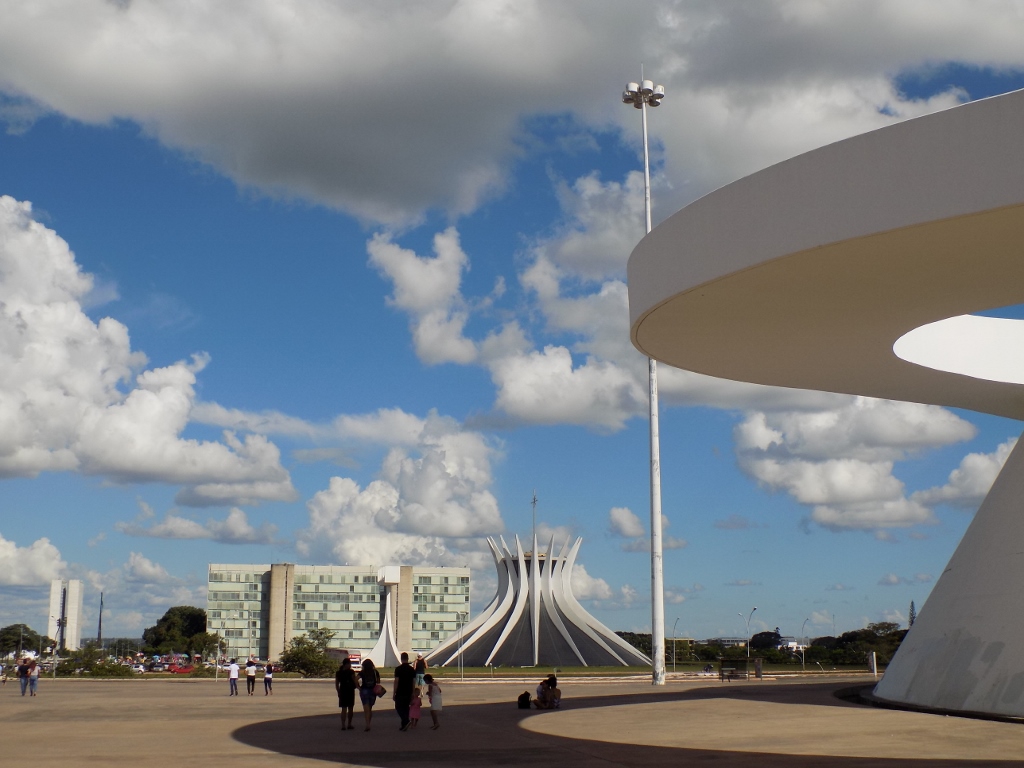 From left to right: National Congress, Ministries, Cathedral and a part of the National Museum
From left to right: National Congress, Ministries, Cathedral and a part of the National Museum
The full name of the cathedral is the Metropolitan Cathedral of Our Lady of Apparitions (Catedral Metropolitana Nossa Senhora Aparecida). However, this was less important to me. What was important indeed was that it looked – amazing!
It was designed by architect Oscar Niemeyer and its appearance is truly and completely unique.
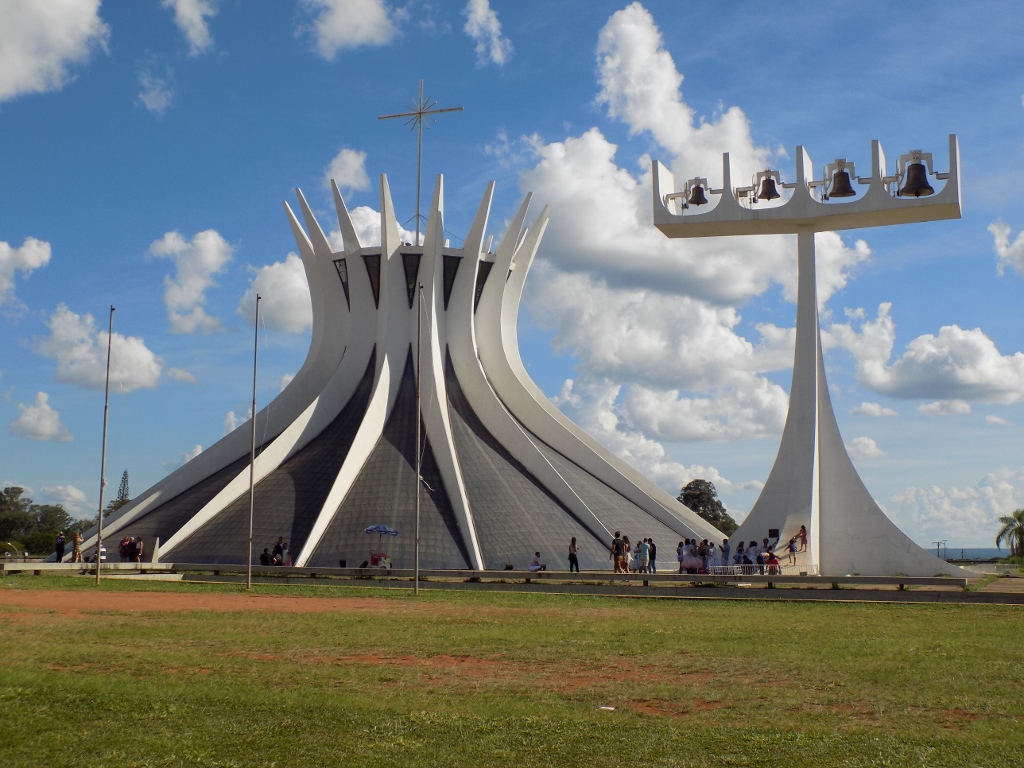 Cathedral and the bell-tower
Cathedral and the bell-tower
It is possible to find data on the internet regarding different aspects linked to the construction of the Cathedral in terms of who was in charge of the artistic details, where the bells were cast and so on, so I will not repeat this here and go into such level of details. After all, I personally did not care much about all of this.
What I believe to be important is that the Cathedral is entered by a ramp that goes underground, since what is seen on the surface is in fact only the roof of the Cathedral! In front of the ramp there are sculptures of the four Evangelists.
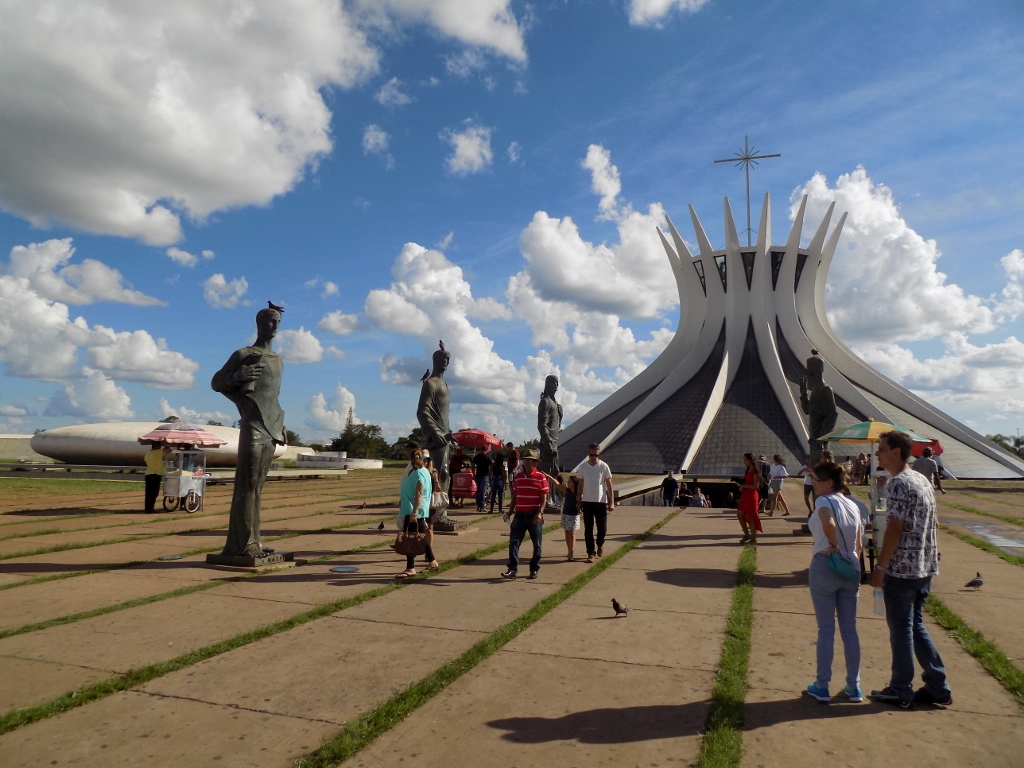 Cathedral and its entrance that goes below; in front of it there are the four Evangelists and to the left, behind the cart with popcorn, there is the roof of the baptistery
Cathedral and its entrance that goes below; in front of it there are the four Evangelists and to the left, behind the cart with popcorn, there is the roof of the baptistery
Before entering the Cathedral, one needs to breathe deeply and well, since once inside you will become breathless.
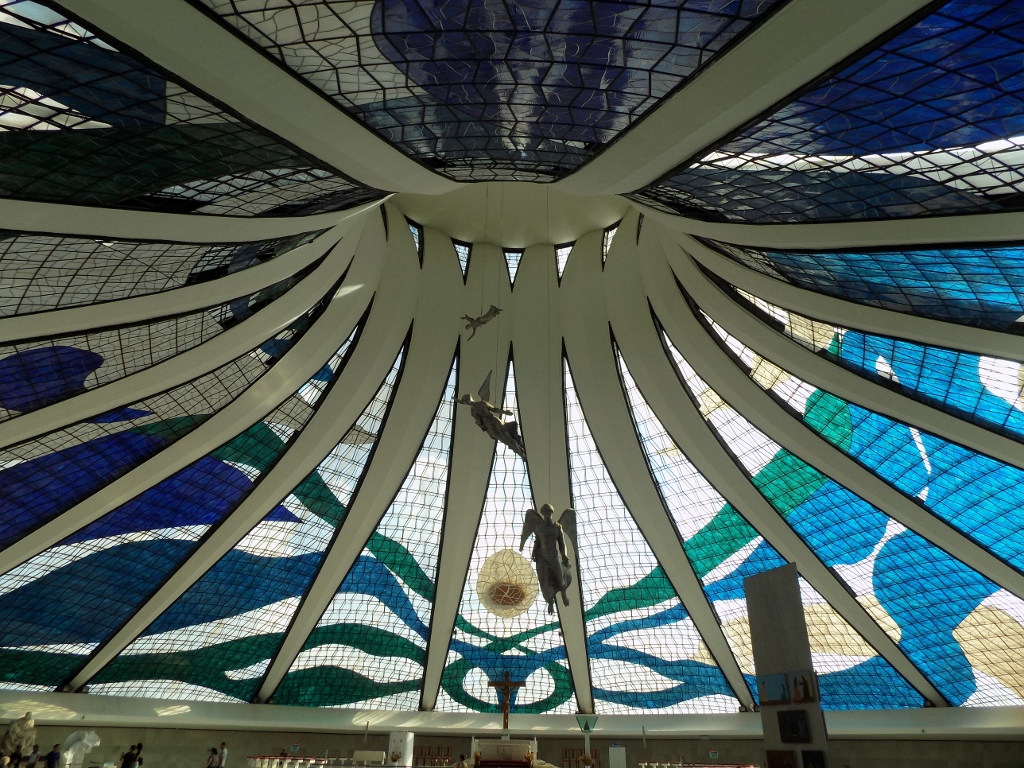 Cathedral, the interior
Cathedral, the interior
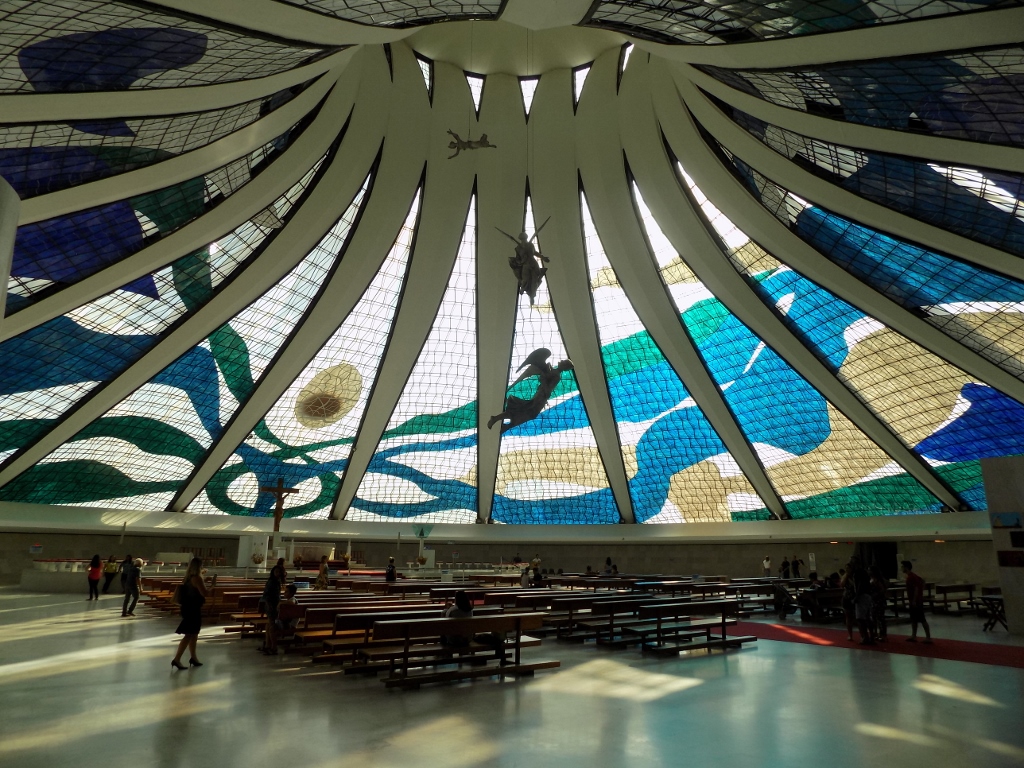 Cathedral, the interior
Cathedral, the interior
The roof consists of 16 concrete pillars between which there are fibreglass panels, while three angels hang from the roof in the centre.
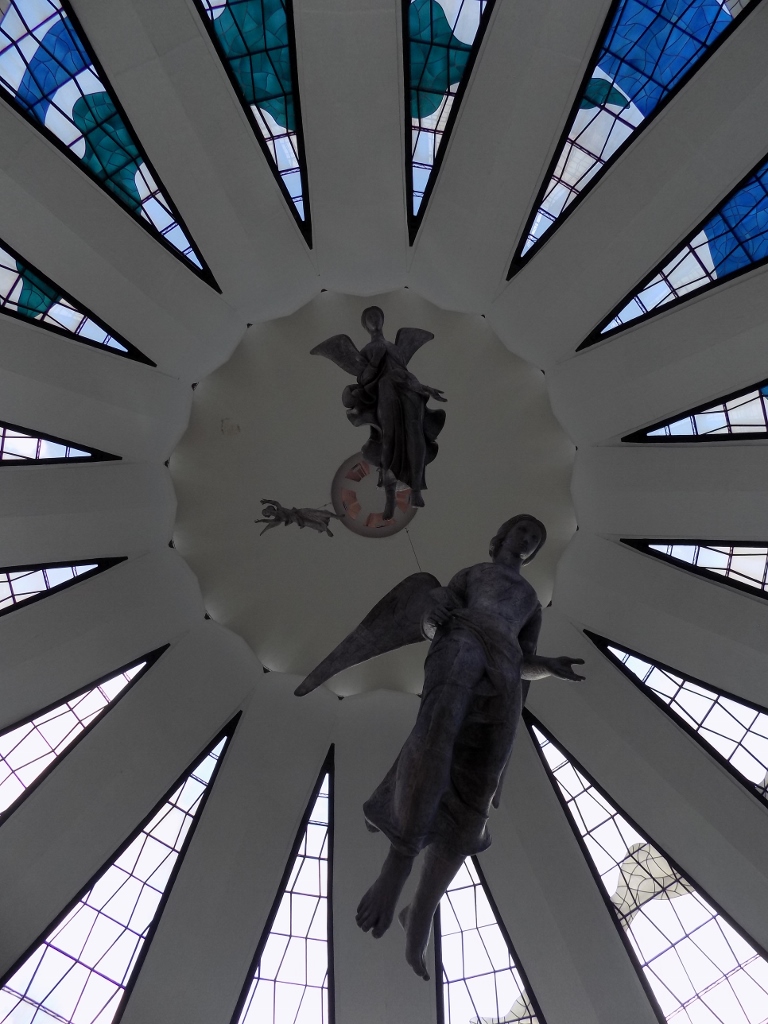 Cathedral, the interior
Cathedral, the interior
The experience was completely fantastic and there I started to fall in love not only with the Cathedral, but also with Brasilia itself, created through this amazing play of adult architects, designers and artists.
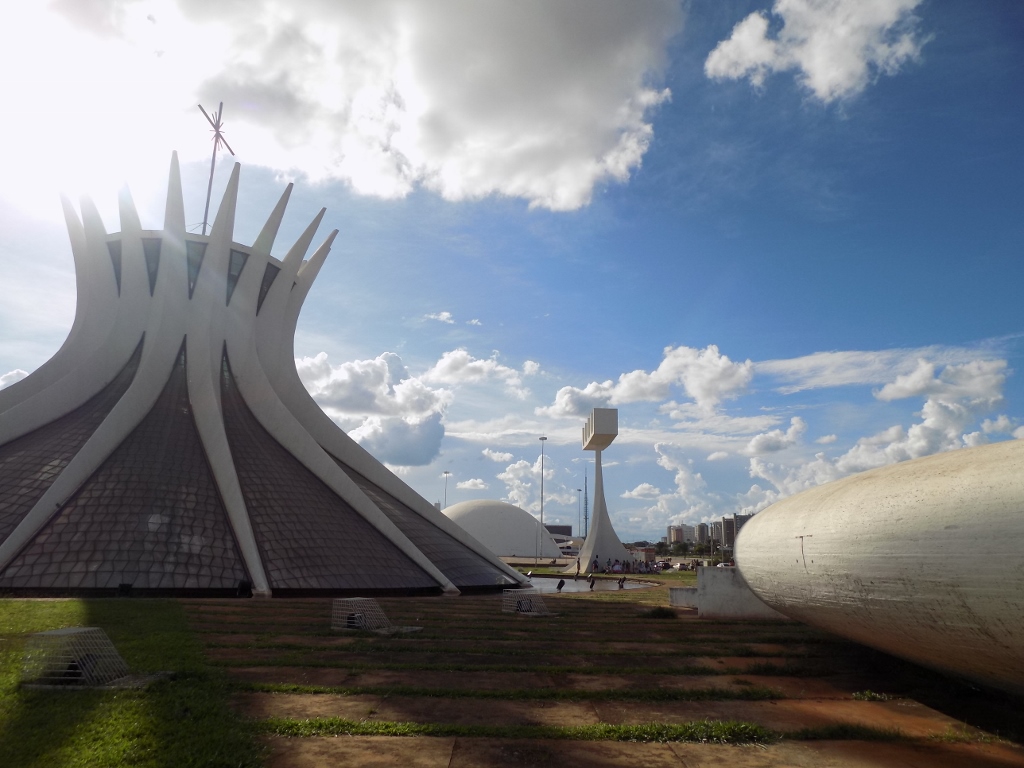 From left to right: Cathedral, National Museum (a little farther), bell-tower and the roof of the baptistery
From left to right: Cathedral, National Museum (a little farther), bell-tower and the roof of the baptistery
After the visit to the Cathedral we headed to the other side of the street and we only took a glimpse of the National Congress building that was farther down at the end of the enormous lawn in the centre of the Monumental Axis (Eixo Monumental).
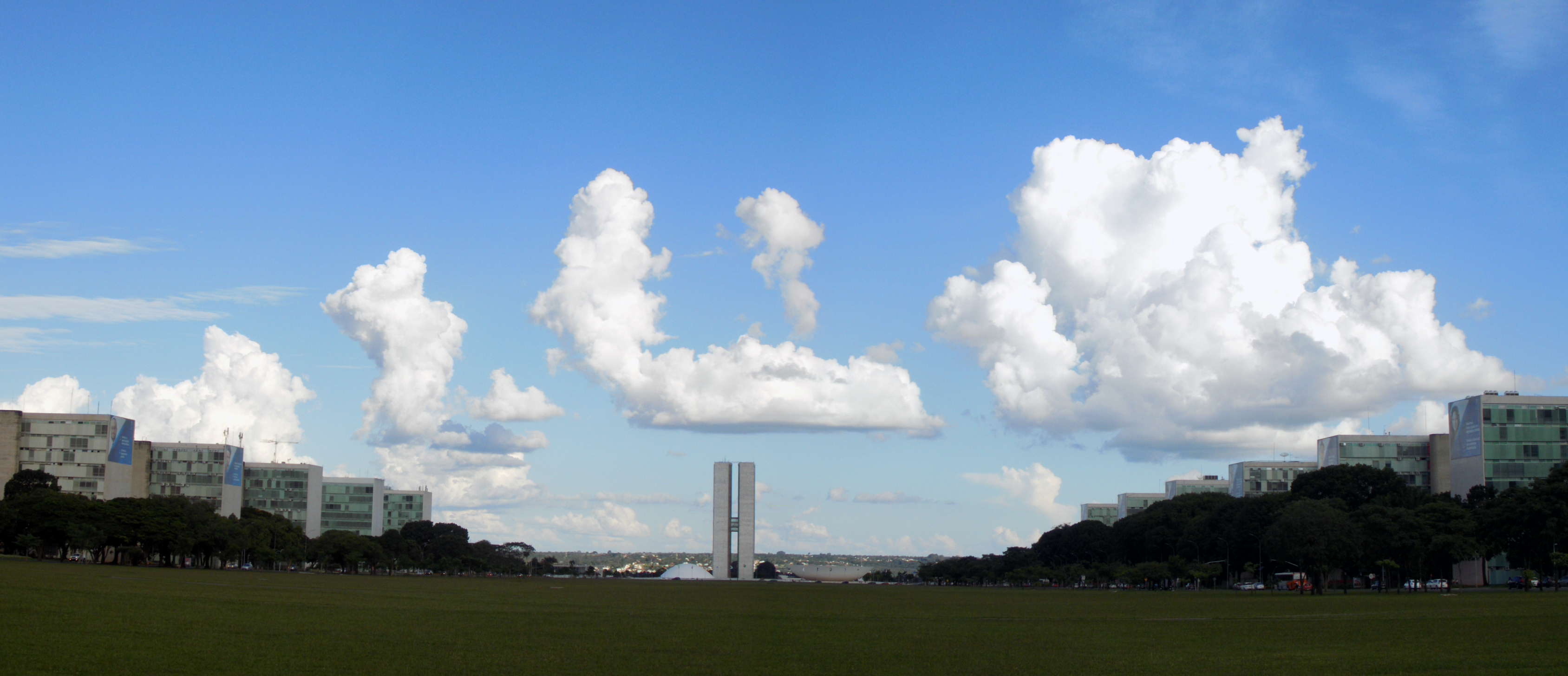
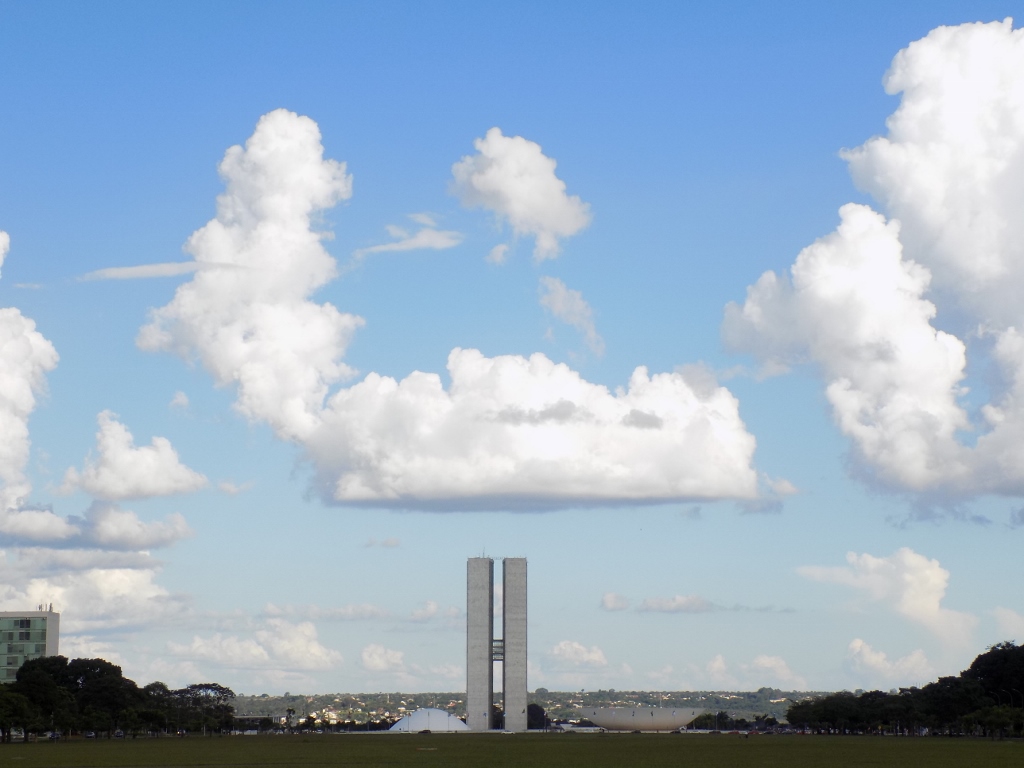 National Congress and an unusual cloud
National Congress and an unusual cloud
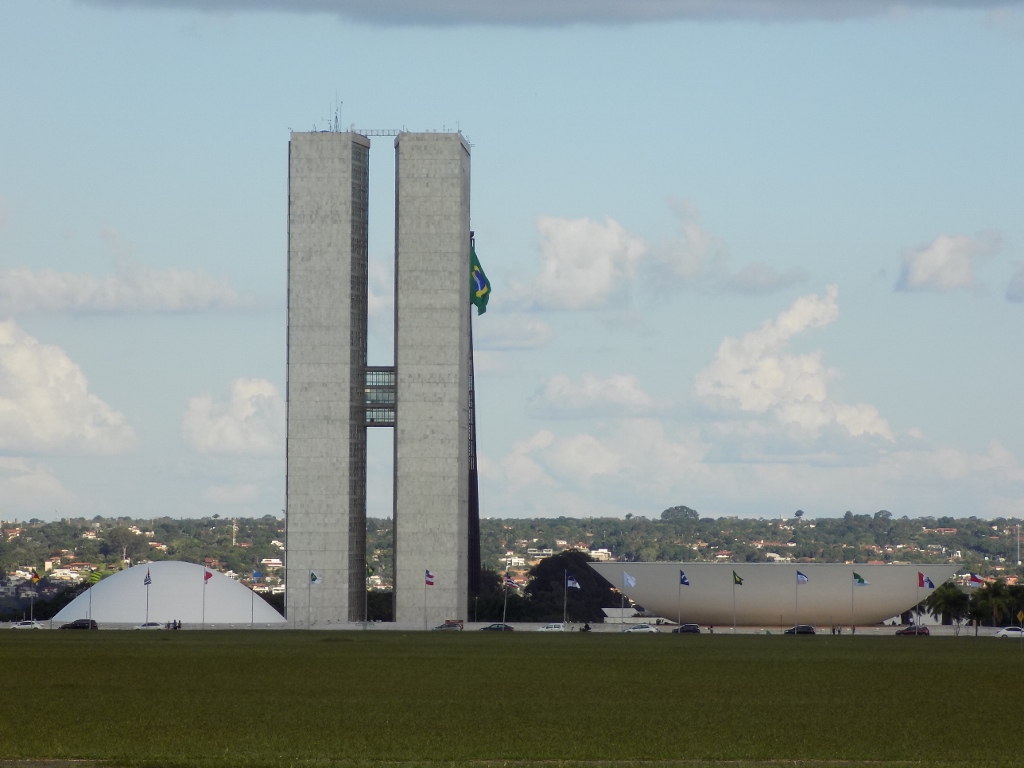 National Congress
National Congress
On the other side of the Monumental Axis, with respect to the National Library and the National Museum, there is the National Theatre, another incredibly interesting building also designed by Oscar Niemeyer.
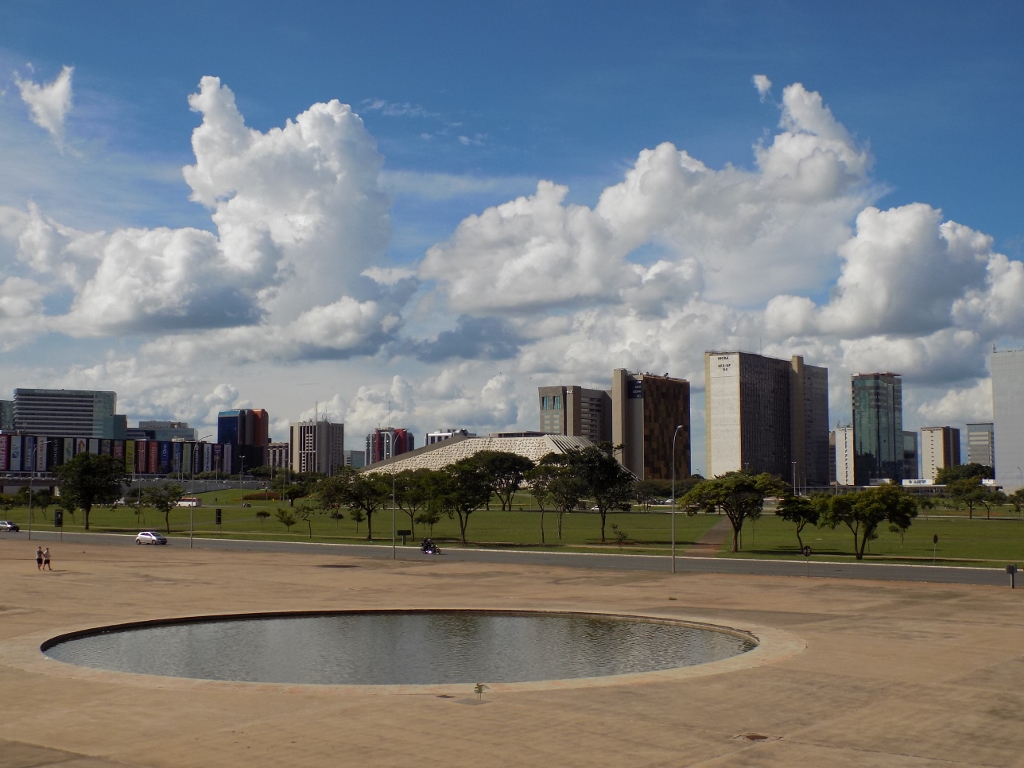 View at the National Theatre from the other side of the street
View at the National Theatre from the other side of the street
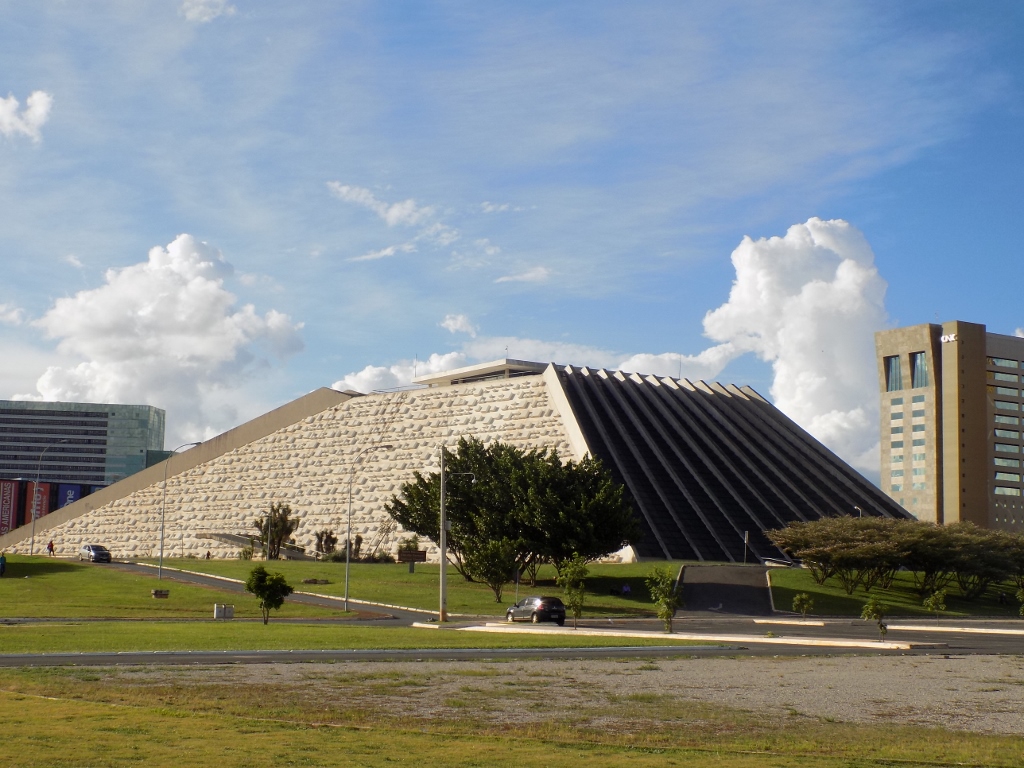 National Theatre
National Theatre
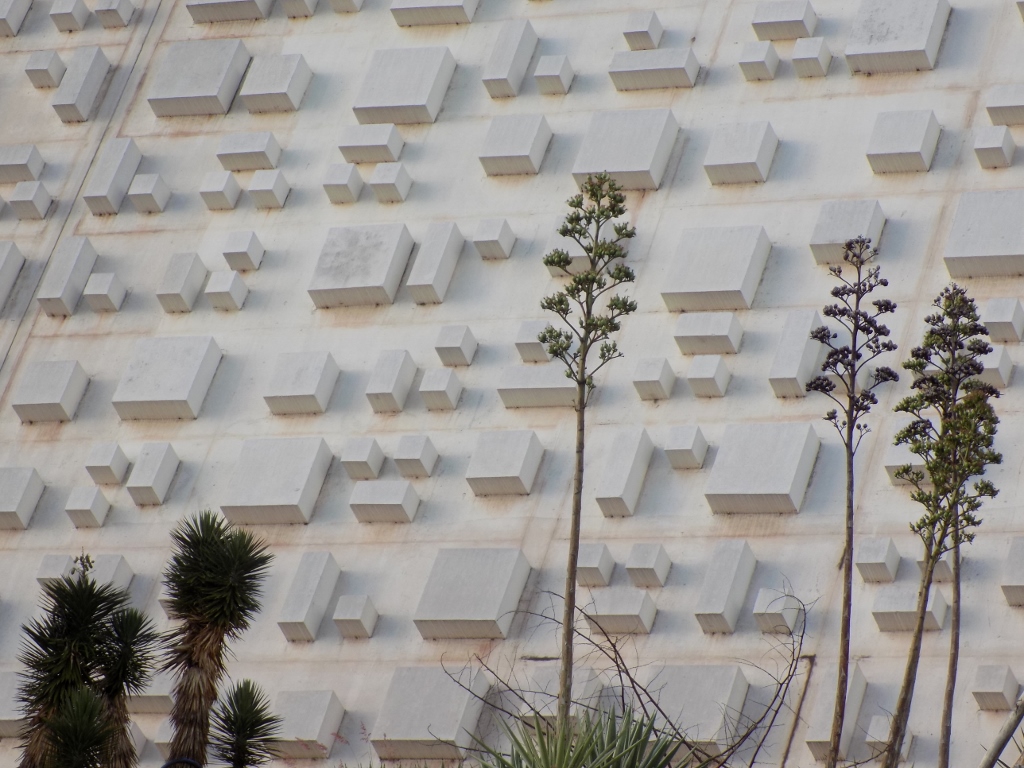 National Theatre, a detail
National Theatre, a detail
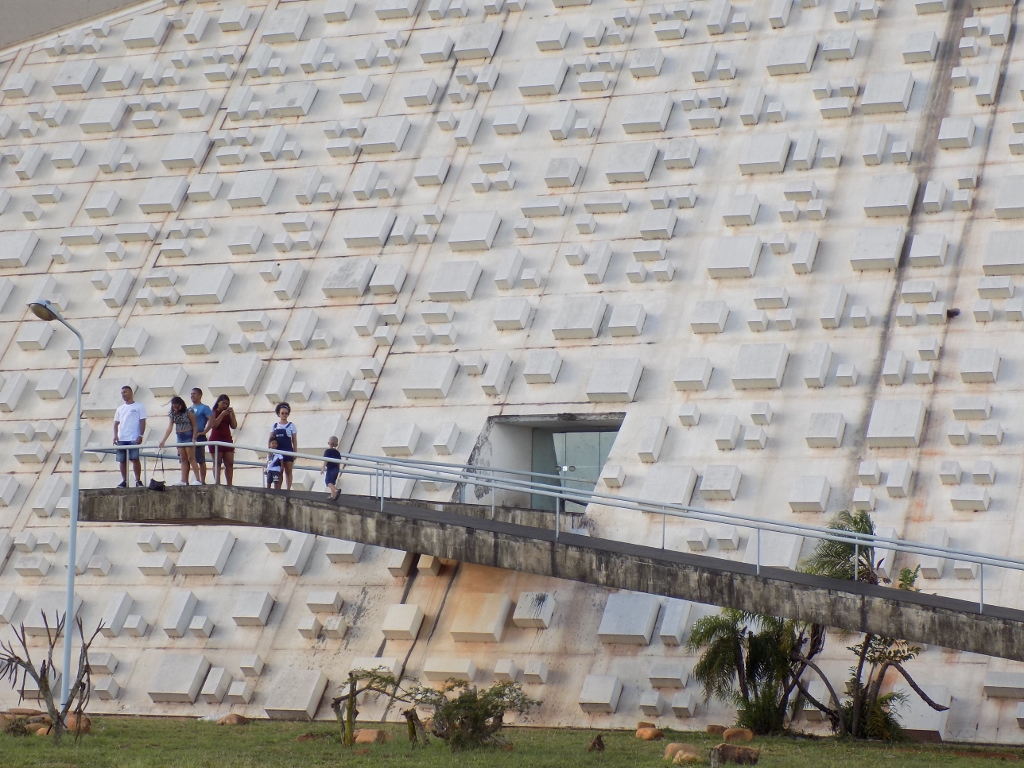 National Theatre, a detail
National Theatre, a detail
Moving further, I looked back once again towards the National Museum and the Cathedral.
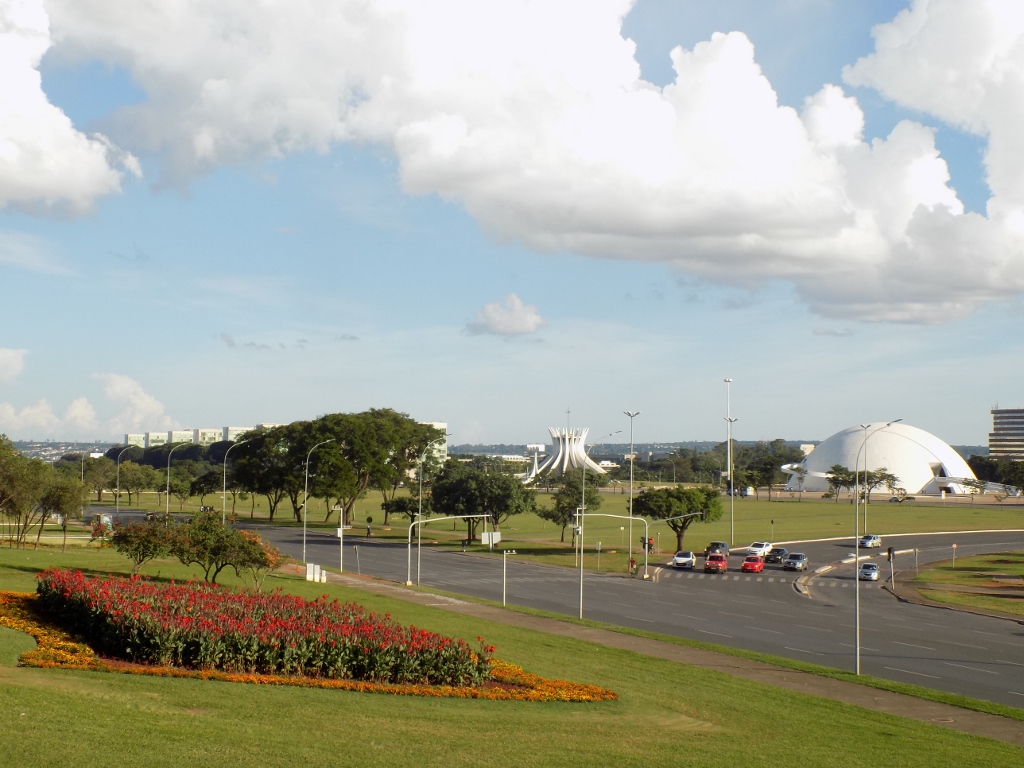 View at the Cathedral and the National Museum
View at the Cathedral and the National Museum
Then we made a stop to have a light dinner and it felt good to go back to the hotel room early also in order for the two of us to get in touch with our dear people.
The following morning, even before breakfast, I went to the top of the hotel where there was a small swimming pool in order to suntan a little and start to prepare my skin for the expected future exposures to the Sun. But, this did not last for too long, since we had plans for this day.
Originally, I had planned to go to the town of Goiás, but at the time I did not bother too much about the planning of this excursion. I just took a glance of the map and concluded we would do it in a day. But... The distances in Brazil are truly incredible and a mere glance of a map may be deceitful. This was the case with me. When I started to plan the daily trip in more details I realised this was completely impossible. The distance between these two places is 310 km at best, plus there is no direct transportation. In other words, my original plan was off and we decided to spend the day in Brasilia instead.
I had also thought that we could see and visit Brasilia within a few hours, but this is actually not really feasible, since the capital of Brazil is quite large. When they decided to build it, they had all the space they wanted at their disposal and, by God, they did use it. Walking is an option, but only for minor endeavours. There are taxis, of course, but it turned out they prefer to be called rather than to drive around the city (practically I don’t remember seeing any other tourists who walked occasionally like we did). Since our mobiles were roaming, we did not call taxi, but tried to use the public transportation.
There is an incredible multitude of public transportation lines in Brasilia. Some of the lines are marked by two figures, some by three, but there are also those with four figures that have a dot either after the first or after the third figure. As it would turn out at certain point, it is very important to pay attention to these dotted figures, similar to decimal numbers.
To start with, we caught a bus that goes in circles along the avenue that runs the length of the Monumental Axis and thus we got off by the Palace of the Ministry of Justice. This building was also designed by Oscar Niemeyer in 1962, but the famous architect himself had certain modifications made to the building in 1987.
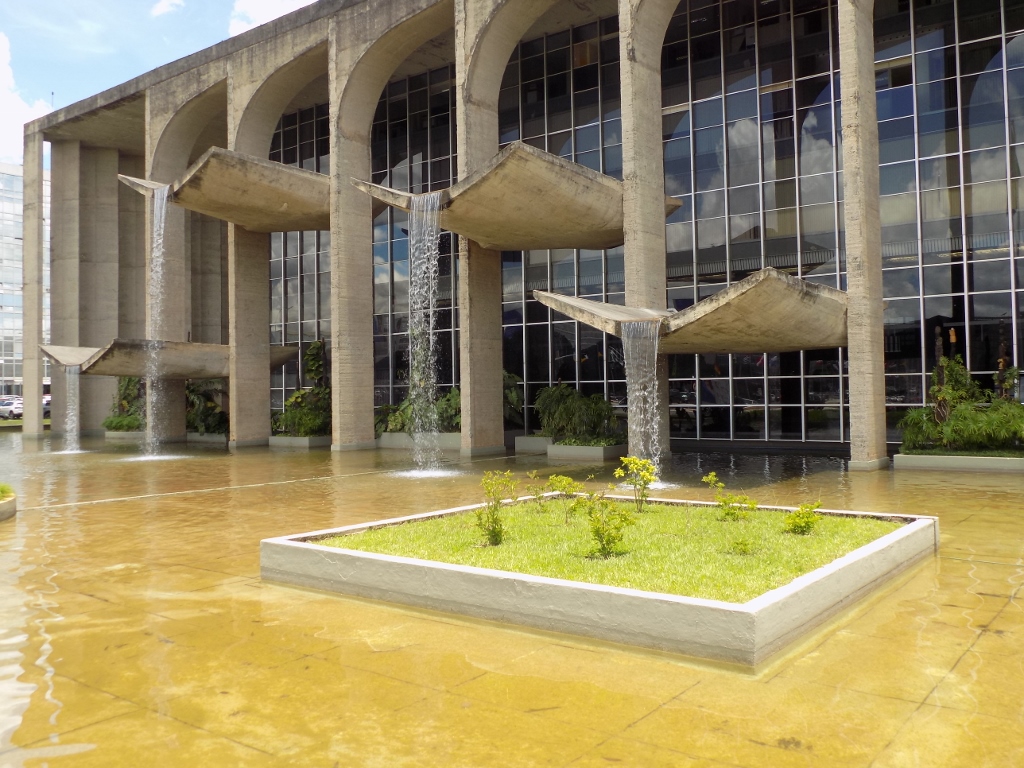 Palace of the Ministry of Justice, a part of the front facade
Palace of the Ministry of Justice, a part of the front facade
From there, one just needs to cross the street to find oneself within the block that includes the National Congress Palace.
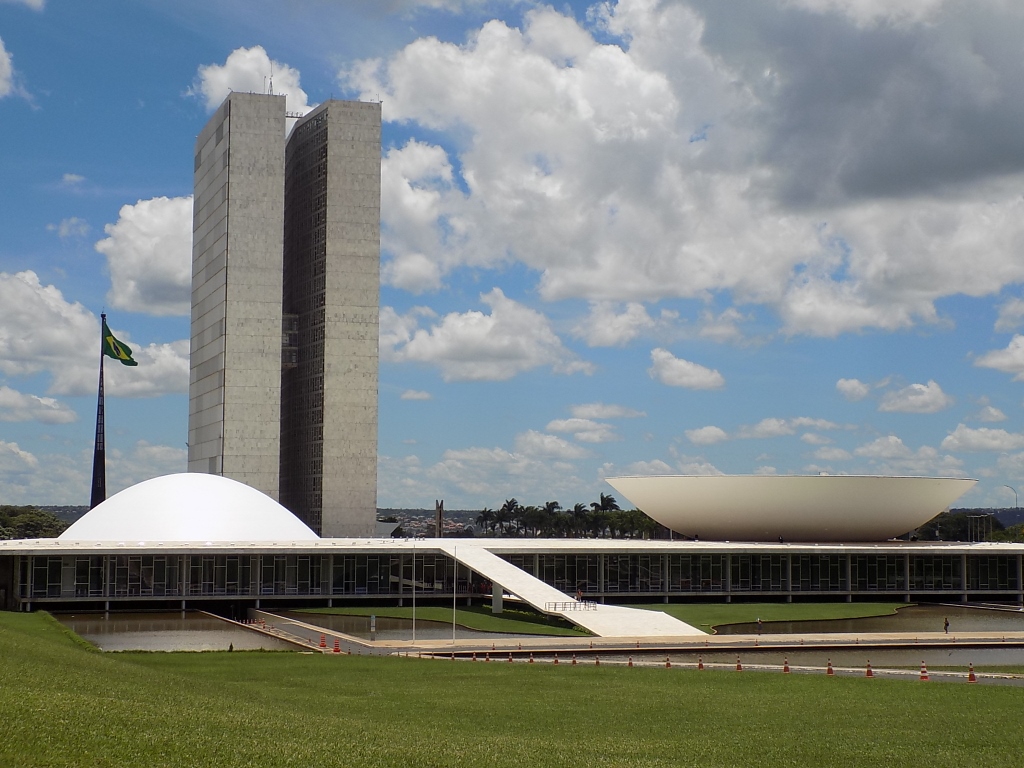 National Congress Palace
National Congress Palace
This is the seat of the legislative authority of Brazil and as a building it is the most famous work of Oscar Niemeyer who did the design on the basis of a drawing by urban-planner Lucio Costa who envisaged the entire plan for the construction of Brasilia. The main elements are an inverted dome that rises above the House of Representatives, a dome that is above the Senate and two 28-storie buildings that are positioned asymmetrically in order to visually balance out the previously mentioned domes. When the building was officially inaugurated, in April 1960, this marked the official move of the capital from Rio de Janeiro to Brasilia.
The two of us even entered the building, but it turned out that at the time they only had guided tours in Portuguese and the two of us were not willing to wait for the one in English.
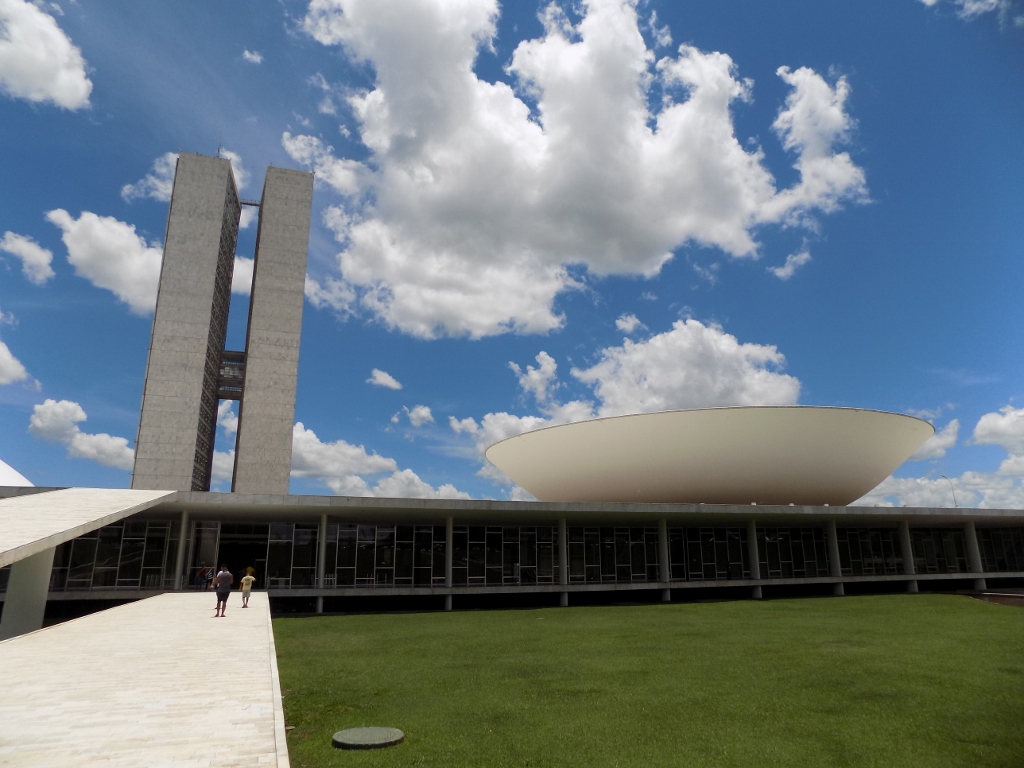 National Congress Palace, entrance into the building
National Congress Palace, entrance into the building
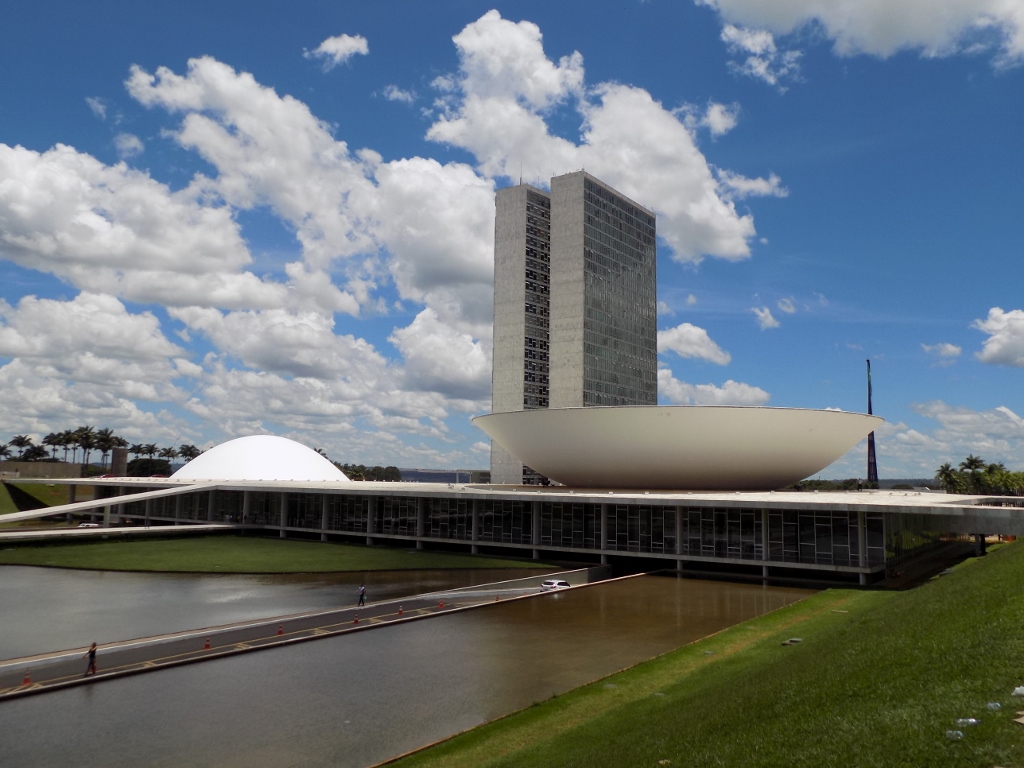 National Congress Palace
National Congress Palace
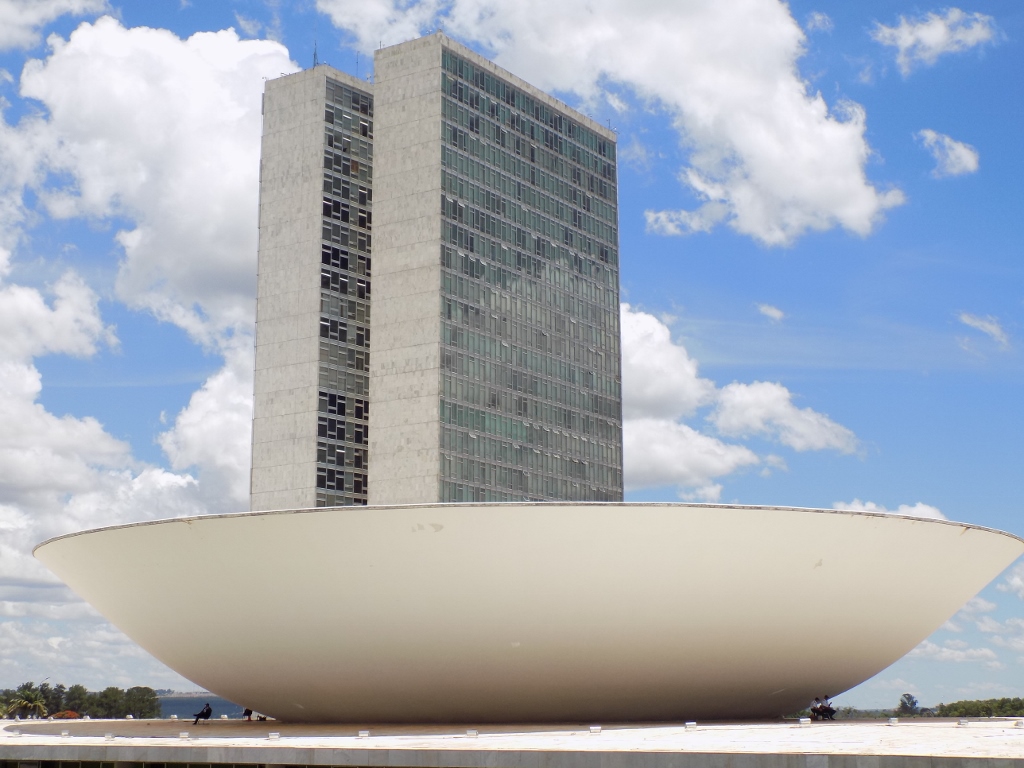 National Congress Palace, a detail
National Congress Palace, a detail
So, we continued with our walk and reached the Three Powers Plaza (Praça dos Três Poderes) that is located behind the National Congress Palace. This actually concerns the legislative authority that is in the centre of the square (National Congress Palace), as well as the executive authority (Presidential Palace) and the judicial authority (Supreme Court) that flank the square. We decided to make a circle around the entire complex first and then to stop by a tourist information office that is located at the square itself in order to get more information about some particular things we were further interested in.
To start with, we reached the building of the Supreme Court.
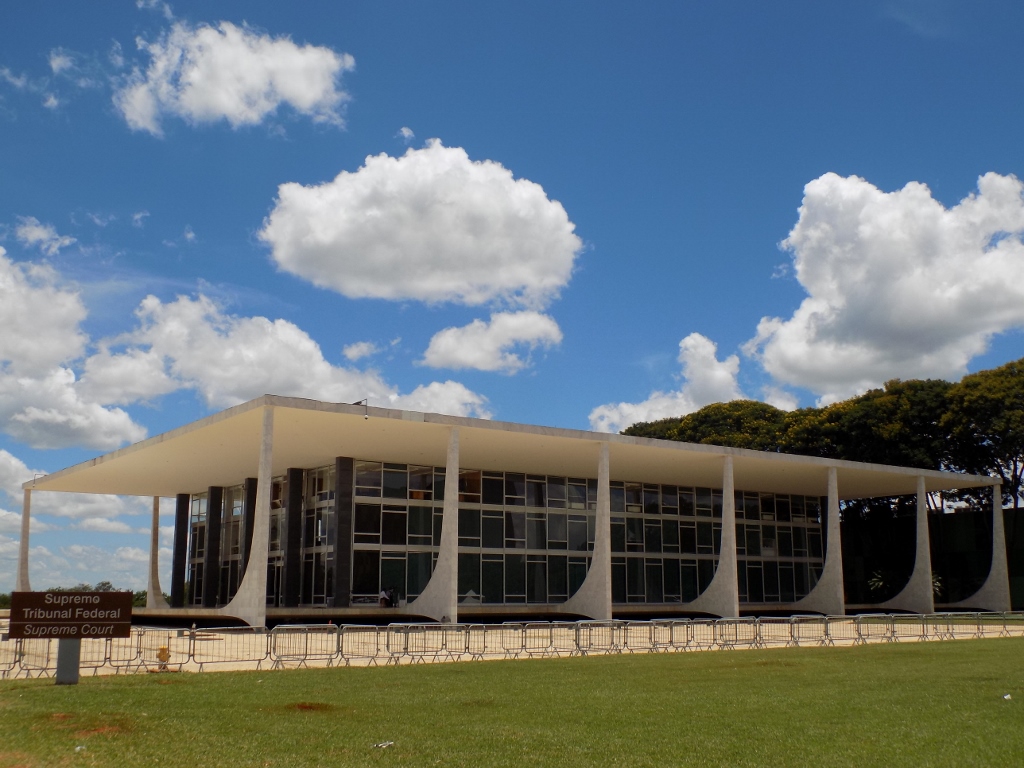 Supreme Court building
Supreme Court building
It is interesting that even the 3-metre high Goddess Iustitia or Lady Justice, as it is often called nowadays, was made in a modern style, but she did retain the blindfold.
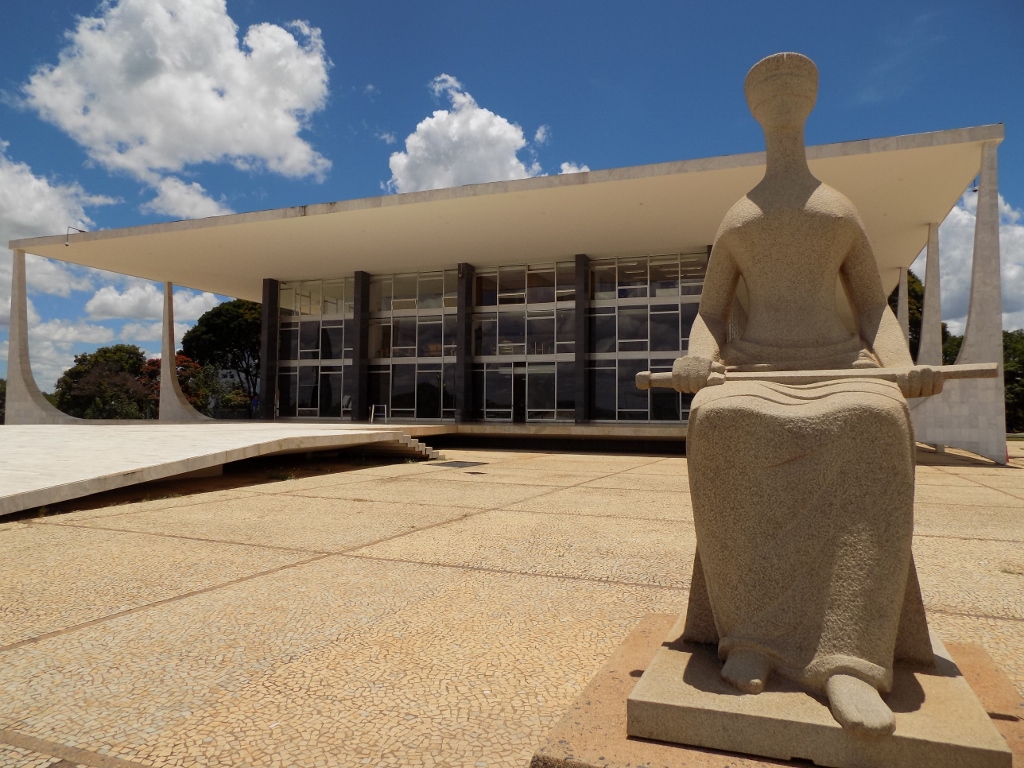 Supreme Court building and the Goddess Iustitia
Supreme Court building and the Goddess Iustitia
On the other side of the square, across the Supreme Court, there is the Presidential Palace that serves as the office of the incumbent Brazilian president (the official residence is in another location). The building is officially called the Planalto Palace (Palácio do Planalto).
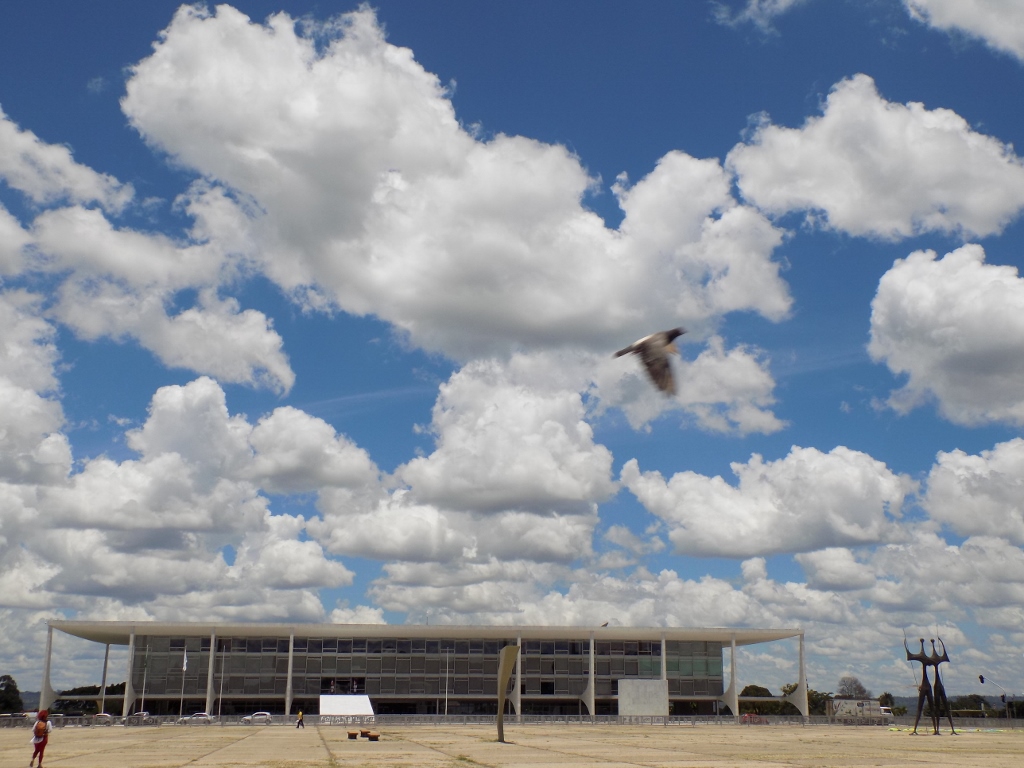 Presidential Palace with one of the better known monuments to the right, one of the symbols of Brasilia
Presidential Palace with one of the better known monuments to the right, one of the symbols of Brasilia
The monument seen in the picture above is called “Two Candangos,” candango being a word that denotes the workers who were engaged on the construction of Brasilia, so the monument is dedicated precisely to them.
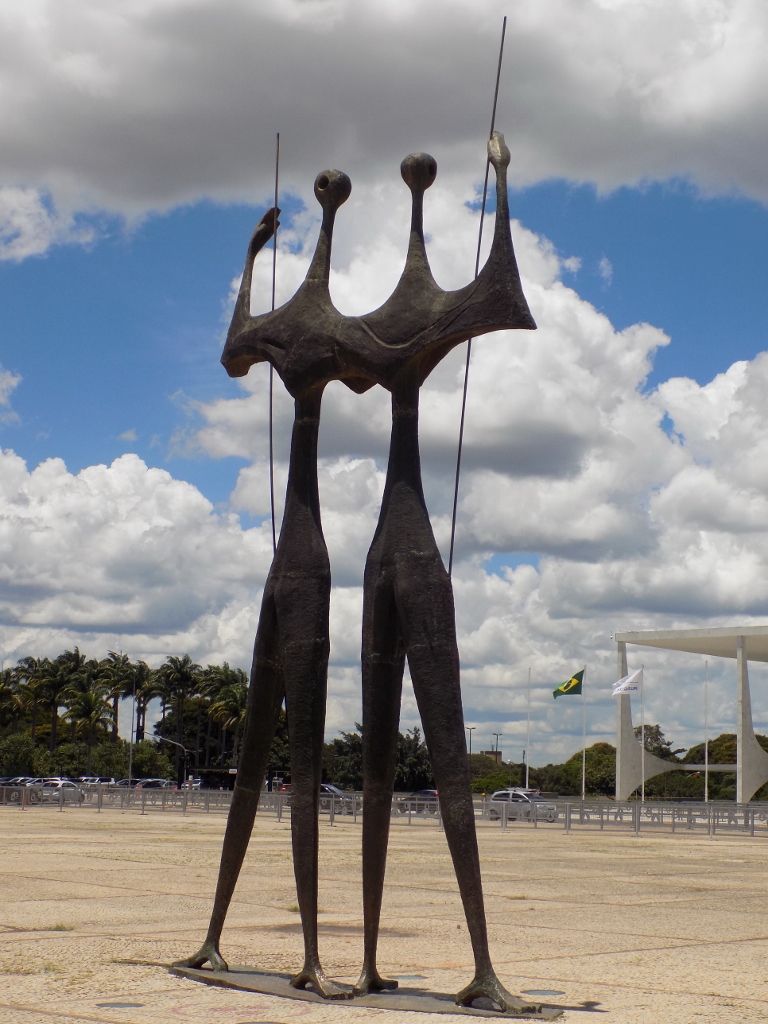 “Two Candangos”
“Two Candangos”
Then it turned out that the tourist office was closed and since both of us felt hot, we were ready to sit somewhere and have something to eat. In our guide book we found a restaurant that did not seem too far away, while it was near the lake, so we headed in that direction. Thus we entered a large park.
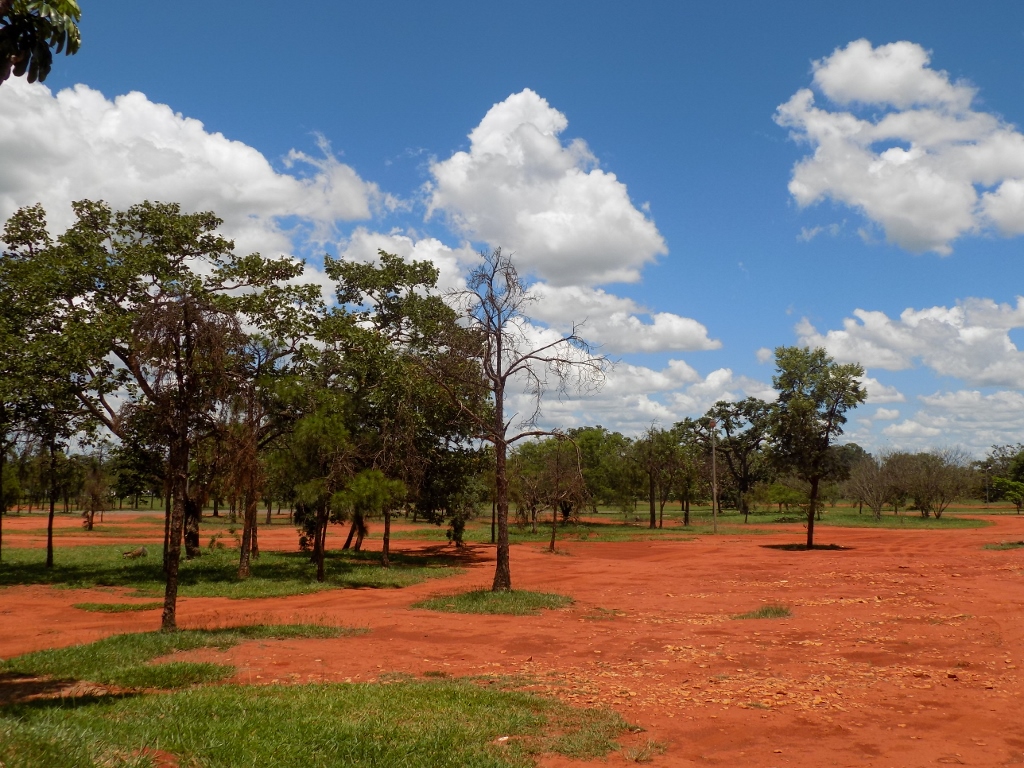 Large park behind the Three Powers Plaza
Large park behind the Three Powers Plaza
As it may be clearly seen from the photo above, on this scorching day, there was absolutely nobody else around but the two of us. That is, nobody of the Homo sapiens sort. But, we did see a southern crested caracara that was peacefully walking around the park, before I chased it away from here through my attempts to take a photo of it from up close.
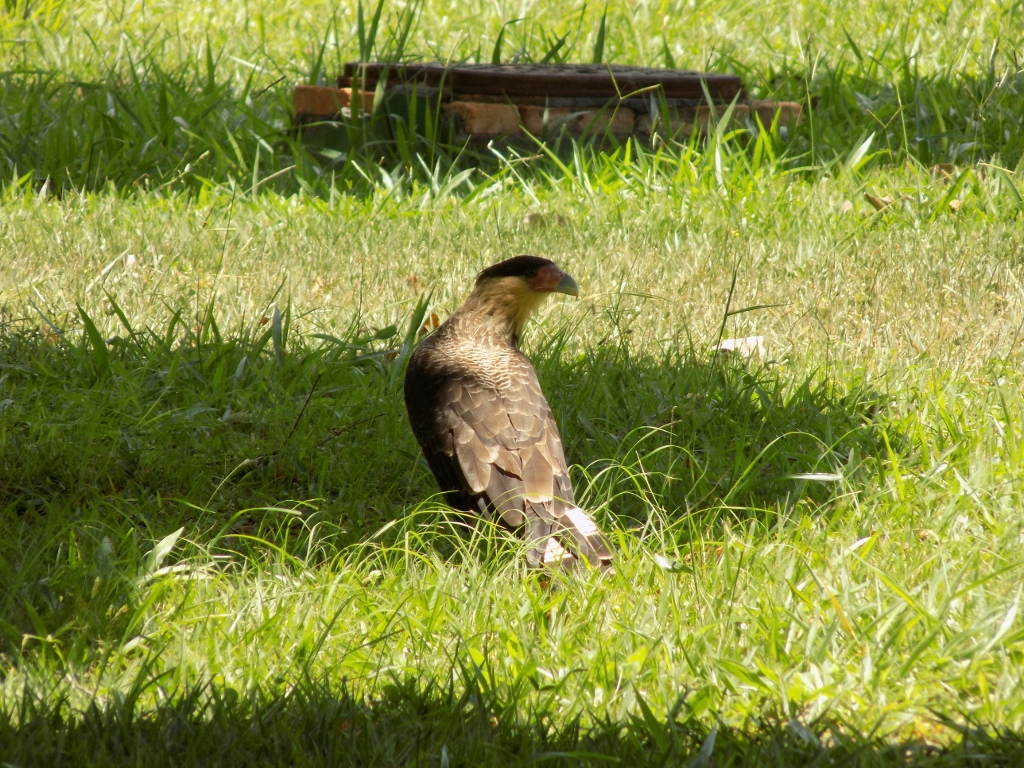 Southern crested caracara
Southern crested caracara
Then we saw some buildings and continued in that direction hoping we would at least find somebody there who may show us the exact direction in which the restaurant we were trying to find was. The buildings that belong to the Public Procurement Agency were fantastically interesting, especially on this day when there were clouds in the sky.
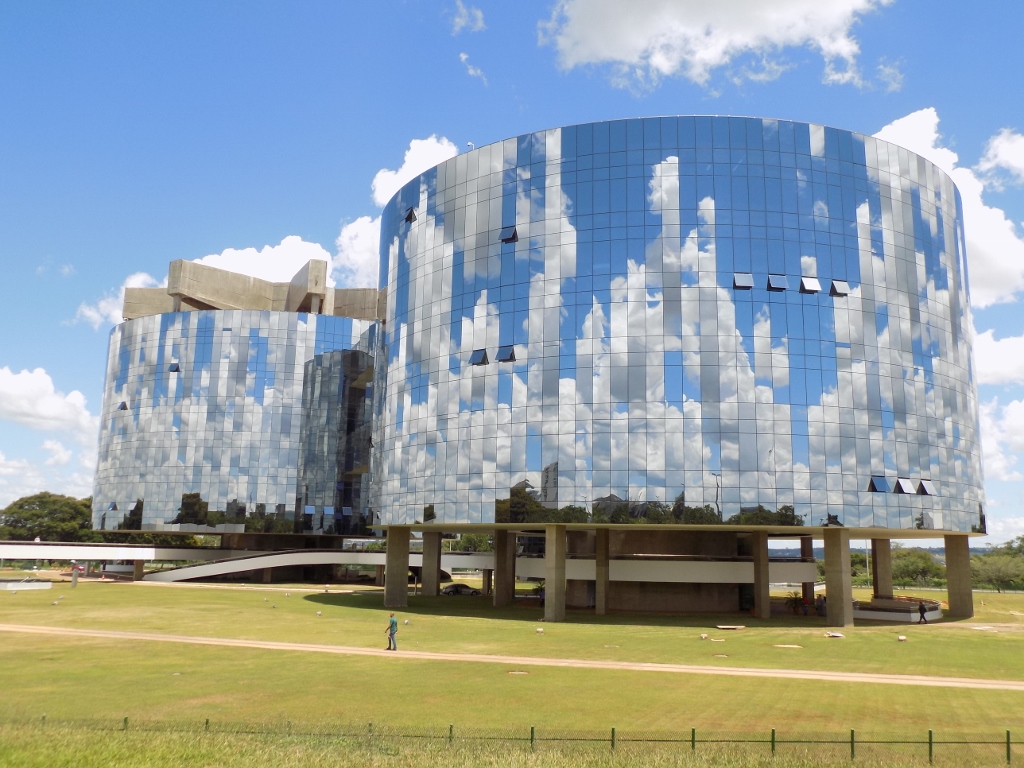 Public Procurement Agency
Public Procurement Agency
In fact, we did not get close to these buildings, but rather we approached some others that were on the side, since there was also a small guard booth. We asked the guard about the restaurant and in our attempt to explain to him what we were after, we mentioned coffee and then he said that we can have coffee in one of those buildings on the side. We thought it was some local café that was mainly intended for the employees and the visitors, so we entered the building. The people working at the reception desk who looked at us all flushed on account of the heat were rather puzzled by our arrival, but when we mentioned coffee, they kindly pointed at some thermoses for coffee that were standing on a small table in the lobby, along with plastic cups. We got the message alright and although we felt silly, we did help ourselves to some coffee, kindly thanked all of them and went out. Outside, it was still as hot.
We continued to locate the damn restaurant or at least the path that would lead us there for another ten minutes, but except that park and a large street along which a car or two occasionally passed, we did not see anything else. Then we finally got fed up by this pointless wandering and we just felt too hot, so since we noticed a bus stop, we sat there and started to wait for a first bus to arrive. We did not care about the number of the line at all.
After a while, a bus did arrive and we entered. It drove around and round and we decided to see this as a sightseeing tour, trying to figure out where it was taking us. I’m not sure how successful we were at this, but we did get lucky in the end, since after half an hour the bus brought us back to the Three Powers Plaza.
As it turned out, right on time to see a change of the guards at the Presidential Palace.
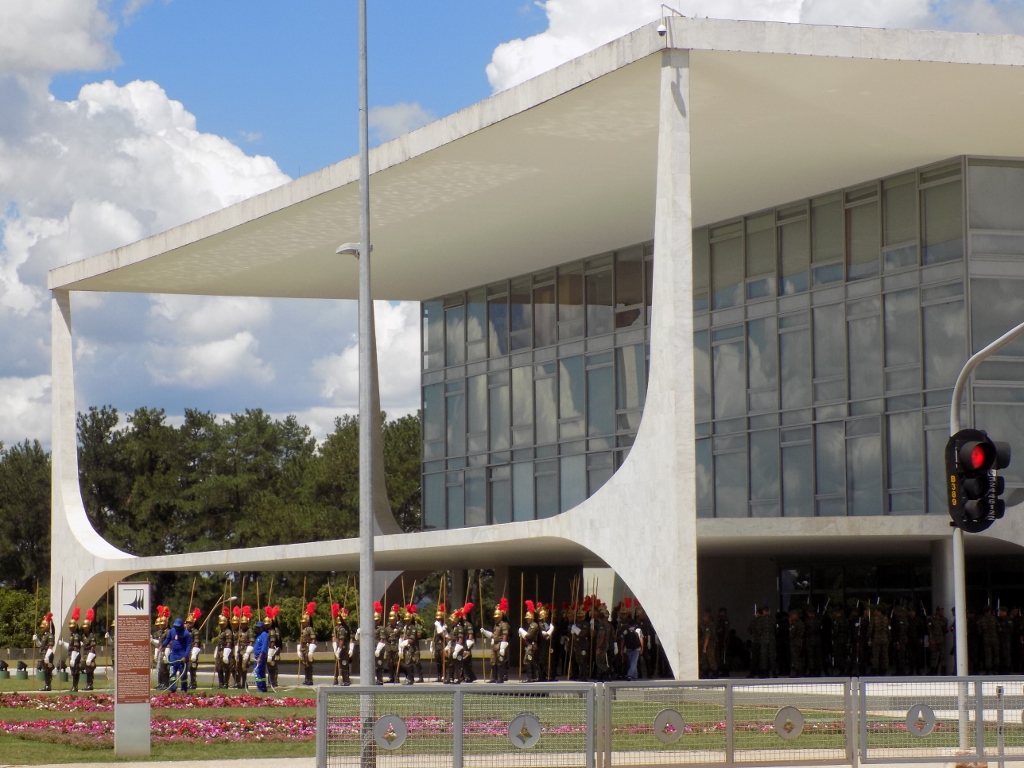 Change of guards at the Presidential Palace is about to begin
Change of guards at the Presidential Palace is about to begin
When we got there, the guards were actually just standing there waiting for something. On the other side of the street, the two of us were not alone, there were also a dozen young Brazilians, and we all hoped to see something interesting. Since nothing happened for a while and there was an ice-cream cart on our side of the street along with a parasol, the two of us bought ice-cream and asked the guy who was selling it if it would be ok to stand under the parasol. Of course it was ok, so we continued to watch the events by the Presidential Palace, but while eating ice-cream in the relative shade, which made the whole situation significantly more bearable.
The soldiers walked to the ramp used to enter the palace and took their positions there, but in our opinion there was nothing important taking place there, so we eventually gave up and walked around the square some more.
Across the National Congress, there is a mast with Brazilian flag and a Cultural Centre with eternal flame dedicated to Tancredo Neves who was elected President in 1985, but died before taking up the office.
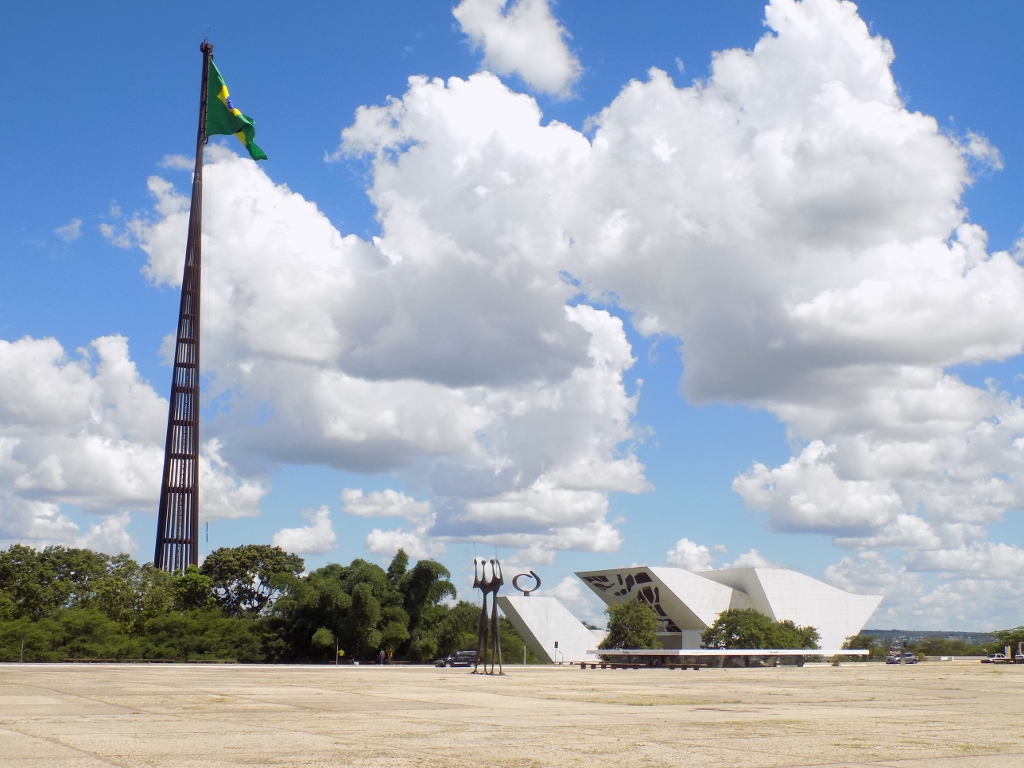 From left to right: mast with the flag, monument to the workers, eternal flame and the Cultural Centre
From left to right: mast with the flag, monument to the workers, eternal flame and the Cultural Centre
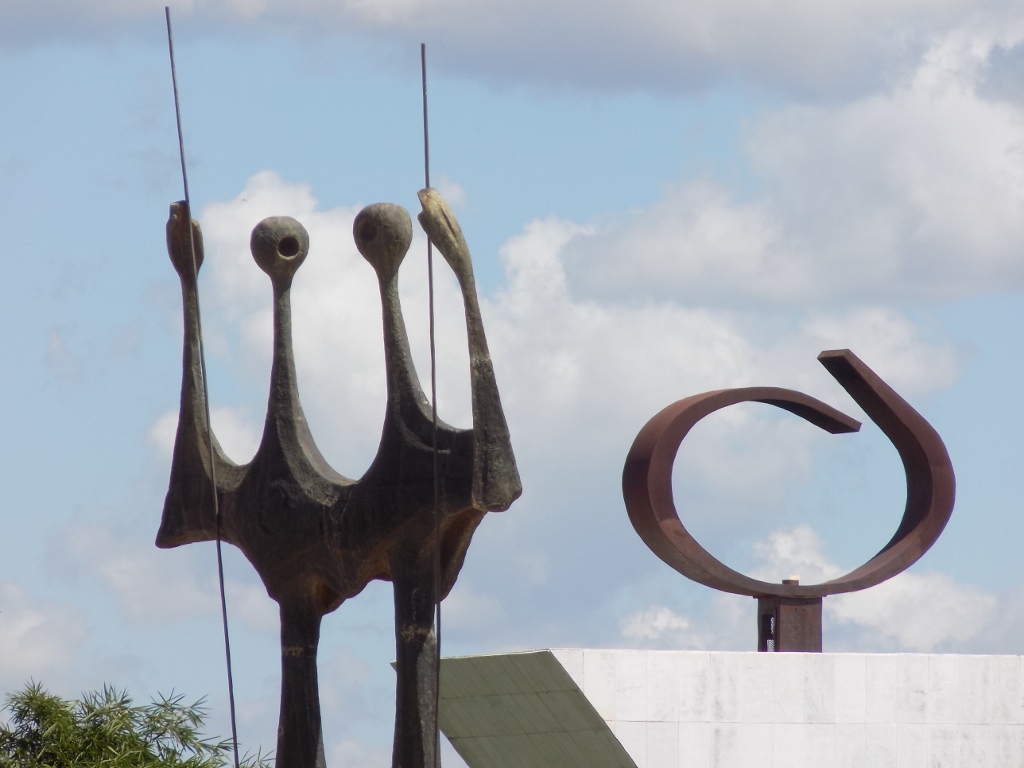 Monument to the workers “Two Candangos” and the eternal flame
Monument to the workers “Two Candangos” and the eternal flame
As it turned out, the tourist information office was open now, so we went there to ask some questions. We also got a significantly better map, but we had no intention of walking around any longer. Among other things we asked which bus we should take in order to get to the presidential residence, the Alvorada Palace, in order to see it, since it is also interesting and important on account of its architecture. The very kind young man working at the office told us and wrote down the numbers of the bus going in that direction and then we went over to a nearby bus stop.
Soon came a bus with appropriate numbers and we got on, but this turned out to be a good lesson about the need to follow the number, as well as letters. This time, the bus did not have a letter it was supposed to have, although all the numbers were in place, so we ended up not seeing the presidential residence after all, but for the same amount of money we drove around for some 40 minutes and the bus took us to its final destination, the Central Station of city buses, which was merely 2 kilometres away from our hotel. By this time we were fed up by bus experiments for the day, so we continued on foot. We also went for some light lunch before returning to the hotel to rest and refresh a little, since we had a plan for the evening as well.